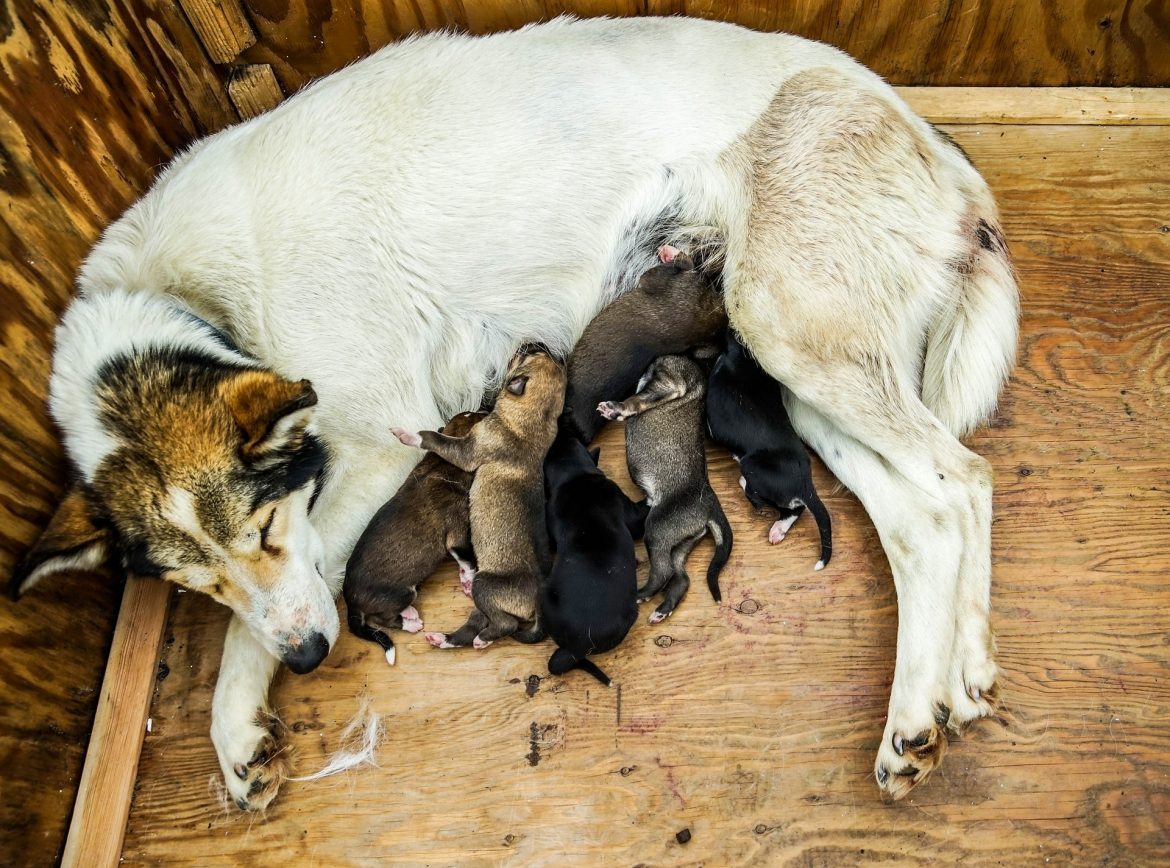Mastitis in dogs is common during or after pregnancy. But mastitis can also affect any dog irrespective of gender, age, and breed. Though canine mastitis can be fatal, early detection and treatment will reduce discomfort and save your dog’s life.
Have you noticed your dam rejecting its puppies or wincing in pain when breastfeeding? It is necessary to always check for mastitis symptoms, regardless of whether your dog has whelped before or is starting its pregnancy journey.
What is mastitis in dogs?
Mastitis is a bacterial infection of the teats or the whole mammary gland. Though the disease is more rampant in other mammals, it also affects dogs and occurs in two forms;
- Galactostasis
- Acute septic mastitis
Galactostasis is the mildest form of mastitis in dogs. It shows up at the later stages of pregnancy and is characterized by an accumulation of milk in the breasts. It makes the teats painful and causes hardening of the mammary gland due to milk accumulation, leading to a ‘caked breast’. Galactostatis can result from a false pregnancy or a miscarriage as well.
Acute septic mastitis is a fatal version of canine mastitis. It not only affects the teats but the entire mammary gland too. In many cases, an abscess form in the mammary gland or the dam, ending up bed-ridden. It would be best if you treated acute septic mastitis immediately to prevent loss of life.
Nursing dogs are more vulnerable to canine mastitis. As puppies constantly suck on the mom, cracks appear on the teats, making it possible for bacteria to enter and cause infection. Also, scratching on the teats while suckling creates avenues for bacterial infection.
Initially, the bacteria only affects the teats causing swelling and some pain. But if untreated, bacteria spread to the mammary glands and worsens the condition.
Symptoms of mastitis in dogs
Puppy rejection is one of the early signs of mastitis in dogs. However, the mother dog refusing to feed its puppies could be due to puppy teething. As a puppy grows its teeth, it accidentally bites when suckling, and this causes a lot of discomfort for the mom. Check to see if the puppies are teething when you notice the mother dog refusing to feed the litter.
If the puppies are not teething and you suspect canine mastitis, check for these symptoms as well;
- Teats feeling warm or hot to the touch
- Lumps in teats
- Pain in teats or mammary gland. Mother dog winces when you touch these two areas.
- Dam appears restless
- Sudden weight loss
- Mother dog whining or crying all the time
- Mom snapping or growling at puppies out of
- Dehydration in the mother dog
- Puppy neglection by the mother dog
- Bruises or purple tint around the teats
- Fever
- Immobility, especially in acute cases
Another way to spot mastitis in dogs is by checking the health of puppies each week. If you notice a reduction in weight or zero weight gain in the puppy, there is a chance the puppy is not feeding well because the mom denies it milk.
Mastitis in dogs can occur without evident infection. A pregnant or nursing dog can suffer mastitis due to the accumulation of milk in the mammary glands causing them to appear distended. Also, any form of trauma to the mammary gland can be the onset of canine mastitis.
Diagnosing mastitis in dogs
Take your dog to the vet if they exhibit symptoms of canine mastitis. Also, do not allow the puppies to continue feeding on the mom’s milk as infected and toxic.
The vet will observe and palpate the dog’s teats for signs of infection. A milk sample is taken as well to check for bacteria, blood and pus. A complete blood count test also helps determine how far the disease has spread. In severe cases of canine mastitis, an ultrasound is necessary to identify tumours or abscess in the mammary glands.
Note that canine mastitis can exhibit symptoms similar to hypothyroidism. Your vet will perform a thyroid profile to rule out hypothyroidism.
Home treatment for mastitis in dogs
An outpatient approach is the best for treating mastitis in dogs. It allows the mother dog to spend time nurturing the puppies even if it is not suckling them. Also, treating canine mastitis depends on the severity of the infection.
For Galactostasis mastitis, treatment involves a cocktail of antibiotics and painkillers. Also, apply a warm compress on the affected area to provide relief from swelling. A cabbage leaf compress is ideal for reducing both pain and inflammation in the affected area. Ensure the compress is secured around the affected gland and allow it to sit for 2 to 4 hours. Change the compress after another 4 hours until the swelling or inflammation has gone down.
Puppies can still feed on the mother’s milk if the milk cytology test returned negative for any traces of pus, blood, or bacteria. Only let the puppy suckle when the swelling and inflammation subside.
For severe or acute septic mastitis, your vet will recommend hospitalizing the mother dog for better treatment. The dog will be on drip medication to administer antibiotics through the body constantly. During this treatment period, intravenous fluids are also necessary to ensure the dam remains hydrated.
Draining any visible abscess around the mammary gland to reduce pain and infection. Ensure you trim any hairs around the swollen area. It prevents the draining fluids from drying on the strands, which can re-introduce bacteria back to the drained wound.
Surgical removal of severely infected gland tissues is vital to stop the infection from spreading. Post-surgery recovery is usually fast, albeit there will be some cosmetic changes to the dog’s underbelly.
How to prevent mastitis in dogs
The best way to prevent mastitis in dogs is by keeping the whelping area clean and sanitized. Dispose of used paper towels and change the dog’s beddings. Clean used towels, feeding bowls, and any material used in the whelping pen. Always sanitize your hands and wear sterile gloves when handling the dam or litter. Also, wear gloves when serving food and clean water to the mother dog and its puppies.
You will have to tube-feed your puppies for the period the mother dog is recovering from mastitis. Check out our article on how to tube feed a puppy in 5 easy steps. Alternatively, watch the video below on how to syringe-feed a puppy.
I am a highly skilled content writer and SEO expert with a passion for helping small businesses succeed in the digital world. With my extensive knowledge of the latest SEO techniques and strategies, I have successfully assisted numerous clients in improving their website rankings, generating more leads, and driving a significant increase in website traffic.
As a professional content writer and SEO expert, I am confident in my ability to contribute significantly to the success of small businesses. If you are seeking a results-driven, highly skilled digital marketer who can help you increase your ranking, convert new leads, and see a substantial improvement in website traffic, I would welcome the opportunity to collaborate with you.
Website: https://manmadewebsites.com/
Email: hello@digitalmarketingchap.com

